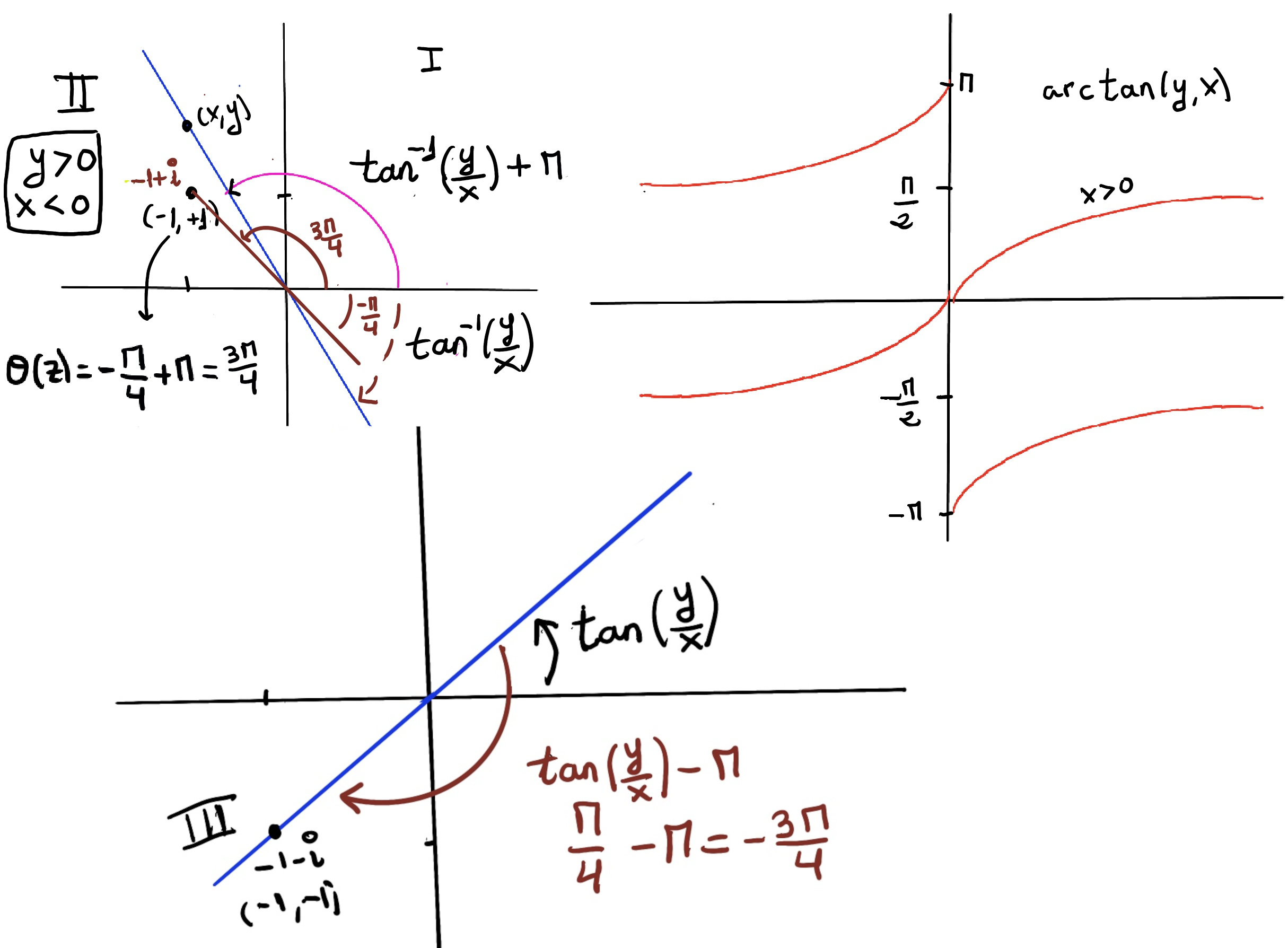
|
 |
 |
When you have eliminated the impossible, whatever remains, however improbable, must be the truth, Sherlock Holmes.

A complex number z can be expressed in the form: z = x + yi where x and y are real numbers, and i is the imaginary unit with the property that $i^2 = -1$.
The argument of a complex number is a fundamental concept in complex analysis. For a non-zero complex number $z = x + iy \neq 0$, its argument (denoted $\arg(z)$) is the angle $\theta$ between the positive real axis and the vector connecting the origin to z in the complex plane. This angle is typically measured in radians, with the principal value (the most commonly used) ranging between $-\pi$ and $\pi$, or sometimes 0 and $2\pi$.
For any nonzero complex number z = x + iy, the argument is the angle $\theta$ such that: $z = |z| e^{i\theta}, \theta = \arg(z) = \tan^{-1}\left(\frac{y}{x}\right), |z| = \sqrt{x^2+y^2}$
If $z = x + iy \neq 0: \arg(z) = \theta \text{ satisfying } x = |z|\cos\theta, y = |z|\sin\theta.$ The principal value $\mathrm{Arg}(z)$ is a single‑valued choice of $\arg(z)$ — usually in $(-\pi,\pi]$ — but because angles are defined up to multiples of 2π, the full argument is multi‑valued: $\arg(z) = \{\mathrm{Arg}(z) + 2\pi k, k\in\mathbb{Z}\}$.
Let z = x + iy ≠ 0.
However, the standard argument function has a critical limitation: it is not continuous everywhere in the complex plane. When moving around the origin (e.g., traversing a circle), the argument “jumps” by $ 2\pi $ at the point where the angle crosses a boundary (e.g., from $ \pi $ to $ -\pi $ or vice versa). This discontinuity arises because the argument is inherently multi-valued, and the standard definition restricts it to a specific interval.
Consider a complex number $ z = e^{i\theta} $ (a point on the unit circle) as $ \theta $ increases from $ 0 $ to $ 2\pi $. If we use Arg(z) ∈ (−π, π]:
Therefore, we define the argument as a multi-valued function: $\arg(z) = \\{\theta_0 + 2\pi n : n \in \mathbb{Z}\\}$.
Why no continuous global definition? The domain $\mathbb{C} \setminus \{0\}$ is not simply connected — it has a “hole” at the origin. This topological property causes trouble when trying to define arg(z) continuously on the entire domain:
This is a classic example of a monodromy phenomenon: the value of a function changes when you loop around a singularity.
What about branches? To obtain a single-valued, continuous version of arg(z), you must restrict the domain by introducing a branch cut. For example:
More generally, you can remove any ray from the origin to define a continuous branch:
Let z ≠ 0, arg(z) = {θ₀ + 2nπ: n ∈ ℤ} where $θ₀ = tan^{-1}(\frac{Im(z)}{Re(z)})$.
Proposition. There is no continuous function θ : $\mathbb{C} \setminus \{0\} → \mathbb{R}$ such that θ(z) ∈ arg(z) for all $z \in \mathbb{C} \setminus \{0\}$.
Proof.
Assume, for the sake of contradiction, that such a continuous function θ exists. Define a function g: ℝ→ℝ by: g(t) = $\frac{1}{2\pi}(θ(e^{it})+θ(e^{-it})), t \in \mathbb{R}$
Since by assumption θ is continuous and the exponential function is continuous, g is continuous. For each t, note that: $θ(e^{it}) = t + 2n_t\pi, θ(e^{-it}) = -t + 2m_t\pi$ for some integers nₜ and mₜ.
Therefore, $g(t) = \frac{1}{2\pi}(θ(e^{it})+θ(e^{-it})) = \frac{1}{2\pi}(t + 2n_t\pi -t + 2m_t\pi) = \frac{1}{2\pi}(2(n_t\pi + m_t\pi)) = n_t + m_t \in \mathbb{Z}$.
Thus, g is a continuous integer-valued function on ℝ. The only continuous functions from ℝ to ℤ are constant functions, so g must be constant.
The only continuous functions from ℝ to ℤ are constant functions: 1. $\mathbb{Z}$ is discrete in the standard topology — each singleton {n} is open and closed (its complement is a union of other singletons, which are all open). 2. If $f:\mathbb{R} \to \mathbb{Z}$ is continuous, the preimage $f^{-1}(\\{n\\})$ is open and closed in ℝ for every integer n (continuity preserve openness and closeness). 3. The real line is connected, so the only subsets of $\mathbb{R}$ that are both open and closed (“clopen”) are $\varnothing$ and $\mathbb{R}$ itself. 4. $f^{-1}(\\{n\\})$ must be either empty or all of $\mathbb{R}$. That means f is constant.
Now evaluate g at specific points. At t = 0, g(0) = $\frac{1}{2\pi}(θ(e^{i0})+θ(e^{-i0})) = \frac{1}{2\pi}(θ(1)+θ(1)) = \frac{1}{\pi}(θ(1))$
Since θ(1) ∈ arg(1) = {2πn : n ∈ ℤ}, we have θ(1)= 2πk for some integer k. Thus: $g(0) = \frac{1}{\pi}(2\pi k) = 2k$, an even integer.
At t = π: $g(\pi) = \frac{1}{2\pi}(θ(e^{i\pi})+θ(e^{-i\pi})) = \frac{1}{2\pi}(θ(-1)+θ(-1)) = \frac{1}{2\pi}(2(θ(-1))) = \frac{1}{\pi}(θ(-1))$
Since θ(−1) ∈ arg(−1) = {(2n+1)π : n ∈ ℤ}, we have θ(−1) = (2k′ + 1)π for some integer k′. Thus: $g(\pi) = \frac{1}{\pi}((2k^′ + 1)\pi) = 2k^′′ + 1 \in \mathbb{Z}$, an odd integer ⊥ Since g is constant, we must have g(0)=g(π), but this implies an even integer equals an odd integer, which is a contradiction. Therefore, no such continuous function θ exists.
Conclusion: The argument function theta in the complex plane is classified as a multifunction due to its infinite values for each input.
When we remove a ray from the origin (a branch cut), we can define continuous single-valued branches of the argument function. This works because removing a ray makes the domain simply connected, eliminating the topological obstruction that causes multi-valuedness.
Consider the domain ℂ \ [0, ∞) (complex plane without the non-negative real axis). The multi-valued argument function maps each z to the set: $arg(z) = \\{\theta_0 + 2\pi n \mid n \in \mathbb{Z}\\}$ which can be visualized as the union of intervals: $\cdots \cup (-2\pi, 0) \cup (0, 2\pi) \cup (2\pi, 4\pi) \cup \cdots$
By selecting the interval (0, 2π), we can construct a continuous single-valued argument function: $\theta: \mathbb{C} \setminus [0, \infty) \to (0, 2\pi)$
This branch satisfies: (i). For z in the upper half-plane (y > 0): $\(0 < \theta(z) < \pi\)$, (ii). For z in the lower half-plane (y < 0): $\(\pi < \theta(z) < 2\pi\)$. (iii). As z approaches the positive real axis from above: $y \to 0^+, x \gt 0: \theta(z) \to 0^+$. (iv) As z approaches the positive real axis from below: $y \to 0^-, x \gt 0: \theta(z) \to 2\pi^-$
Now consider removing the ray at the angle π/4 (45°), defined as: $\text{Ray} = \\{re^{i\pi/4} \mid r \geq 0\\}$. The domain is ℂ \ Ray.
The multi-valued argument maps to the set: $\arg(z) = \\{\theta_0 + 2\pi n \mid n \in \mathbb{Z}\\}$ which corresponds to the union of intervals: $\cdots \cup (\pi/4 - 4\pi, \pi/4 - 2\pi) \cup (\pi/4 - 2\pi, \pi/4) \cup (\pi/4, \pi/4 + 2\pi) \cup \cdots$
By selecting the interval (π/4, π/4 + 2π), we construct a continuous single-valued argument function: $\theta: \mathbb{C} \setminus \text{Ray} \to (\pi/4, \pi/4 + 2\pi)$
This branch satisfies: (i) For points just above the ray (As we get closer to the ray from above, the argument values approach π/4 from above): $\theta(z) \to (\pi/4)^+$; (ii) For points just below the ray (As we get closer to the ray from below, the argument values approach π/4 + 2π from below): $\theta(z) \to (\pi/4 + 2\pi)^-$; (iii) As we traverse a circle around the origin (avoiding the ray), θ(z) increases continuously from π/4 to π/4 + 2π
In practice, the argument is computed using the atan2(y, x) function, which accounts for the quadrant of $ z $ in the complex plane.
For $z = x + iy = |z|e^{i·\theta}$,
arg(z) is a multi-valued function given by $|z|=\sqrt{x^2+y^2}, \text{arg(z)} = \\{\theta + 2\pi·n: n \in \mathbb{Z}\\}$.
$\theta = \text{Arg(z)} = \text{atan2}(y, x)$ is a single-valued branch, which by convention is taken to lie in the range $-\pi < \theta ≤ \pi$
For $z = re^{i\theta}$ with r > 0, we define: $\theta(z) = \text{Arg(z)} = \begin{cases} \tan^{-1}\left(\frac{y}{x}\right), & \text{if } x > 0 \\\\ \tan^{-1}\left(\frac{y}{x}\right) + \pi, & \text{if } x < 0 \text{ and } y \geq 0 \\\\ \tan^{-1}\left(\frac{y}{x}\right) - \pi, & \text{if } x < 0 \text{ and } y < 0 \\\\ +\frac{\pi}{2}, & \text{if } x = 0 \text{ and } y > 0 \\\\ -\frac{\pi}{2}, & \text{if } x = 0 \text{ and } y < 0 \\\\ \text{undefined}, & \text{if } x = 0 \text{ and } y = 0 \end{cases}$

Quadrant Handling:
Why $tan^{-1}(\frac{y}{x})$ is insufficient: The standard $tan^{-1}$ only returns values in (−π/2, π/2). The atan2(y, x) function resolves quadrant ambiguities by using both x and y signs.
This implementation ensures continuity everywhere except along the negative real axis, where there’s a branch cut (jumping from π to -π). This formulation is exactly what’s implemented in most programming languages and mathematical software, making it the standard practical approach for complex number computations.
Example 1: z = 1 + i. Here, x = 1 > 0, the argument is $\theta(z) = \tan^{-1}(1/1) = \frac{\pi}{4}$.
Example 2: z = -1 + i. Here, x = -1 < 0 and y = 1 ≥ 0, $\theta(z) = \tan^{-1}(1/-1) + \pi = -\frac{\pi}{4} + \pi = \frac{3\pi}{4}$.
Example 3: z = -1 - i. Here, x = -1 < 0 and y = -1 < 0. $\theta(z) = \tan^{-1}(-1/-1) - \pi = \frac{\pi}{4} - \pi = -\frac{3\pi}{4}$.
Programming Languages
Arg[z]): Returns the principal value $(-\pi, \pi]$.argument(z)): Similar to Wolfram, with the same interval.angle(z)): Also uses $ (-\pi, \pi] $, while atan2(y, x) is explicitly used for quadrants.cmath.phase# Import cmath Library
import cmath
# Print quadrant-aware arctangent
print (cmath.phase(1 + 1j))
# 0.7853981633974483